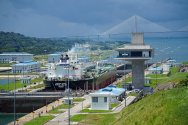US aircraft carrier's sizes is restricted by the width of the Panama canal since passage through the canal is normal routine for USN ships, and since PLAN ships are not likely to go through Panama canal, its future nuclear power super carriers can have wider beam and thus larger displacement.
Just a slight correction - Despite the Neopanamax locks being 55 meters wide (which is larger than the Nimitz and Ford's 41 meter-wide beam) - The flight decks of both the Nimitz and Ford are 76-78 meters wide. That means the USN supercarriers cannot pass through the Panama Canal without massive preparation work beforehand.
Here's one such Neopanamax lock. Notice the installations and structures lining along both sides of the lock.

To match the number of aircraft onboard Ford class super carrier, PLAN may need an aircraft carrier with 120,000 to 150,000 tons displacement capable of carrying 90 to 100 plus aircraft of all types.
What China needs is a powerful nuclear propulsion that is capable of moving the ship at 30 knots and above. Looking beyond 2030 for such break through.
If China's future CVNs are significantly larger and displaces significantly more than USN CVNs, then it might be better to have more than two nuclear reactors onboard.
For comparison:
The Nimitz CVNs are powered by two A4W reactors: 550 MWth each, together generating (estimated) ~208MW for the shafts (one reactor for each pair of shafts) and (estimated) ~200MW of electrical power.
The Ford CVNs are powered by two A1B reactors: 700 MWth each, together generating (estimated) ~260MW for the shafts (one reactor for all four shafts) and (estimated) ~250MW of electrical power.
Last edited:
